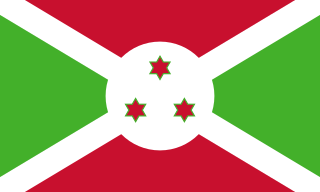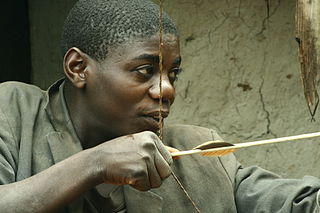
The National Defence Force is the state military organisation responsible for the defence of Burundi.

Burundi is one of the few countries in Africa, along with its closely linked neighbour Rwanda among others, to be a direct territorial continuation of a pre-colonial era African state.
Human occupation of Rwanda is thought to have begun shortly after the last ice age. By the 16th century, the inhabitants had organized into a number of kingdoms. In the 19th century, Mwami (king) Rwabugiri of the Kingdom of Rwanda conducted a decades-long process of military conquest and administrative consolidation that resulted in the kingdom coming to control most of what is now Rwanda. The colonial powers, Germany and Belgium, allied with the Rwandan court.
The Hutu, also known as the Abahutu, are a Bantu ethnic or social group native to the African Great Lakes region of Africa, an area now primarily in Burundi and Rwanda. They mainly live in Rwanda, Burundi, and the eastern Democratic Republic of the Congo, where they form one of the principal ethnic groups alongside the Tutsi and the Twa.

Ntare V of Burundi was the last king of Burundi from July to November 1966. Until his accession, he was known as Crown Prince Charles Ndizeye. After a Hutu-led coup attempt in October 1965, his father, Mwambutsa IV went into exile in Switzerland. In March 1966 Mwambusta IV designated his only surviving son as heir to the throne. The Crown Prince then formally deposed his father and his father's government in July 1966. King Ntare himself was deposed, later the same year, in a military coup led by Michel Micombero; the former king went into exile in West Germany and later Uganda.

The Rwandan genocide, also known as the genocide against the Tutsi, was a mass slaughter of Tutsi, Twa, and moderate Hutu in Rwanda, which took place between 7 April and 15 July 1994 during the Rwandan Civil War.

The Burundian Civil War was a civil war in Burundi lasting from 1993 to 2005. The civil war was the result of long standing ethnic divisions between the Hutu and the Tutsi ethnic groups in Burundi. The conflict began following the first multi-party elections in the country since independence from Belgium in 1962, and is seen as formally ending with the swearing in of Pierre Nkurunziza in August 2005. Children were widely used by both sides in the war. The estimated death toll stands at 300,000.

Banyamulenge, are Tutsi ethnic group that arrived in Congo before the colonization mainly from Rwanda, Burundi and Tanzania. Banyamulenge is a term historically referring to the ethnic Tutsi concentrated on the High Plateau of South Kivu, in the eastern region of the Democratic Republic of the Congo, close to the Burundi-Congo-and Tanzania border.
Since Burundi's independence in 1962, there have been two events called genocides in the country. The 1972 mass killings of Hutus by the Tutsi-dominated army, and the 1993 mass killings of Tutsis by the majority-Hutu populace are both described as genocide in the final report of the International Commission of Inquiry for Burundi presented to the United Nations Security Council in 1996.
These are some of the articles related to Burundi on the English Wikipedia:

The indigenous population of Burundi is divided into three major ethnic groups: Hutu, Tutsi, and Twa. Its ethnic make-up is similar to that of Rwanda. Tensions between ethnic groups exist and have become violent on several occasions since independence.

On 18–19 October 1965, a group of ethnic Hutu officers from the Burundian military attempted to overthrow Burundi's government in a coup d'état. The rebels were angry about the apparent favouring of ethnic Tutsi minority by Burundi's monarchy after a period of escalating ethnic tension following national independence from Belgium in 1962. Although the Prime Minister was shot and wounded, the coup failed and soon provoked a backlash against Hutu in which thousands of people, including the participants in the coup, were killed. The coup also facilitated a militant Tutsi backlash against the moderate Tutsi monarchy resulting in two further coups which culminated in the abolition of Burundi's historic monarchy in November 1966 and the rise of Michel Micombero as dictator.
On 8 July 1966, a coup d'état took place in the Kingdom of Burundi. The second in Burundi's post-independence history, the coup ousted the government loyal to the king (mwami) of Burundi, King Mwambutsa IV, who had gone into exile in October 1965 after the failure of an earlier coup d'état.
Albert Shibura is a Tutsi Hema people retired minister of Interior and Justice and diplomat from Burundi.
In the waning years of the 20th century, ten million people were murdered in various remote parts of Central Africa. It is not a single genocide but a collection of ethnic wars which raged from Sudan, the Congo, through to Uganda and Rwanda.

















